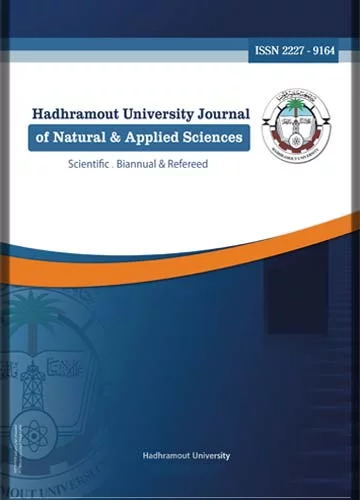An Environmental Study to Adapt some Hadrammout Coast Plant for Drought and Salinity Tolerance
Keywords:
Soot, Salinity, Adaptation, Drought, Soil textureAbstract
The study was conducted between May 2016-August 2017. An auger was used to collect 60 random soil
samples to carry out the physical and chemical analyses.The selected plants were Salola baryosma and
Aeurops lagopoides in the salt marsh and Prosopis juliflora and Calotropis procera in the valleys.The
results revealed clear physical and chemical differences within the soils of the salt marshes and valleys
that prove to be sandy, loamy, basic and saline. All investigated variables differ in the selected areas e.g.
% of sand, silt, clay. The soil of all the salt marshes was devoid of gravel which was abundant in the
valleys’ soils. Similar differences were evident for the pH, moisture content, EC, TDS, SO4 2-, CO3 2- ,Cl- ,Ca+2 , Na+, K+ in the salt marsh and valleys.The results of frequency, density/hectare and richness
indicated that Salsola and Aeluropus and Suaeda aegyptiaca scored the highest values in the salt marsh
and whereas Prosopis and Senna alexandriana Mill and Calotropis prospered within the valleys. The least
values for these parameters were related Dactyloctinium aegyptium (L) Wild, Phonix dactylifera L. in the
salt marsh and Andropogon cucomus and Cynodon dactylon in the valleys. The vegetation of these sand
dunes consists of plants tolerant to the dunes’ harsh environmental conditions e.g. Aeluropus lagopoides
and Prosopis juliflora. The life styles of vegetation included Tree, shrubs, herbs and grasses depending on
the local conditions; shrubs were the most abundant.The chemical analyses results indicated that the
superiority of Umbeekha salt marsh and valley over Boyish and Alaega with regard to Cl-, Na+, K+, Mg+2
and proline constituents within the leaves of Salsola and Aeluropus and Prosopis and Calotropis, The
present study recommended conserving, developing and sustainable management of the vegetation cover
in the study area. Laws and environmental legislations that guarantee rational use must be formulated. To
improve environmental awareness on the importance its vegetation, biodiversity and rationalization of
human activities and to conduct the essential scientific research to improve and conserve.




